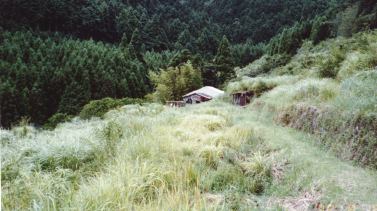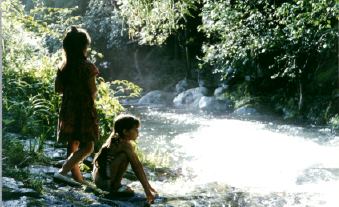'Okunono' - The Farthest Fields ...
As some of you may
know, every summer I leave Tokyo and take my family down to our
'inaka', the
country farm where my wife Michiyo grew up. This year was no
exception, and I thought that for a change in this issue, instead of
our usual 'Visit to a Craftsman', we would take a visit to the old
farm ....
* * *
The hawks sail by high above the old farmhouse,
but nobody is there to watch them pass. The wind rustles the tree
branches on the mountainside, but nobody is there to feel its cooling
caress. The cold, clear stream leaps from stone to stone on its way
through the valley to the distant sea, but nobody is there to hear
its rippling passage.

Okunono, our old family farm, is deserted now. The
grass stands waist high along the footpaths, the fences lean every
which way, the rice paddies and vegetable gardens are thick masses of
tall weeds and wild plants of every description, and the footprints
of the wild pigs are everywhere. It has been so now for five years
... five years since the old folks finally gave up the hopeless fight
against advancing age and advancing nature, and moved down to the
city to live with their children, a generation who have rejected life
here on this mountain. The wild pigs were waiting for that moment.
They had been waiting for a very, very long time.
To reach Okunono one climbs up into the mountains
of the Kii Peninsula in southernmost Mie Prefecture. There is no
electricity, no gas, no telephone ... not even a road, and it is more
than an hour's hard hike from the nearest village. As you make your
way up the forest path, climbing steadily, you pass the remains of
other abandoned farms, the outlines of the old terraces barely
visible here and there among the trees. From the path, one can hear
the stream gurgling away below; the same stream that once fed rice
paddies covering these terraces, supplying food for the many people
who lived here. This valley once held a thriving community, the farms
strung out one after the other in a long chain, with Okunono at the
distant end. Children's voices rang through the air, and echoed off
the tall mountains ....
It was many hundreds of years ago that one of
grandfather's predecessors first made his way up this valley, looking
for places where the mountains relaxed their steepness enough to
allow cultivation. He must have thrust a stick into the ground here
and turned up the rich earth, and decided that he need search no
further ... Every remote village and farm in Japan claims to have
been settled by members of the Heike clan, fleeing from their lost
battles, but here it is true. It must be true. Their voices can be
heard in the night wind, and their lights flicker near the old shrine
on the mountainside above the farm, the one surrounded by the
towering cedar trees they planted to protect it. How hard those men
worked! They dug water channels, shaped timbers for their homes, and
hauled the thousands of stones needed to build the retaining walls
necessary for rice farming on these steep slopes. They built as well
as they knew how, knowing they would never again leave this valley.
They knew also that every following generation would continue the
building, each adding its own contribution to the labours of those
who had come before. The terraces climb up the mountain slopes, each
stone set firmly in place with the knowledge that wild typhoons would
surely come to try and shake it loose. For hundreds of years the
building went on. Hundreds of years of father and son, mother and
daughter, working side by side. Of course each worked to make a
living, to feed themselves, but each also worked to pass on their
farm in better condition to the next generation.
For hundreds of years .... until now. The chain
has been broken, and it is the wild pigs who now claim the
inheritance. The generation who should be living here, who's
children's voices should be echoing through the valley; they have
chosen a different way. They have made a trade. Traded away their
heritage, their history. Traded the hawks and trees and stream, for
concrete apartments, supermarkets, cars, crowds, and noise, noise
everywhere.
Five years ago, when grandfather walked down the
path on his way to the city, leaving his farm for the last time, did
he turn back for one last look?Did he see in his mind the weeds that
would come? Did he ask, "Why?" And did his heart break?

Every summer I leave my apartment in the city and
come and stand here in these fields. I look about me and note the
changes; another tree blocking the path, a new hole in the roof of
the farmhouse, another stone fallen from a wall .... And I ask
myself, "Why am I allowing this to happen?" It is not grandfather who
is to blame for this. He spent his life productively here, and after
his short stay in the city now sleeps in the earth in the village
below. He played his part. It is I who am responsible. Every fallen
stone lies in front of me in silent reproach. I turn my head, and
pretend not to hear, but I cannot avoid the message. Each time I
visit, the chorus of silent voices grows louder and more insistent
.... Come back, they call. Come back.
If I am to answer them it must be soon. Already,
even in these five short years, a great deal of damage has been done,
and in not too many more years, it will be too late. The typhoons
will finish their work, and the wild pigs will have reclaimed what
was taken from them so many, many years ago.
I cried as I wrote these words tonight. Is there
one among you so heartless that he does not cry as he reads
them....?